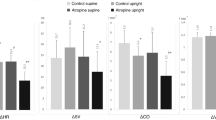Abstract
The influence of respiration on the mean blood pressure\(\bar P_{\text{a}}\) and R-R interval responses at the onset of dynamic exercise was studied in 15 healthy subjects who performed 4 s of unloaded cycling at 1.5–2.0 Hz, 4 s of Valsalva manoeuvre at 5.3 kPa, and a combination of both, each during a 12-s long apnoea at total lung capacity. The R-R intervals were obtained from the electrocardiogram,P a was measured continuously by finger plethysmography, and intra-oral pressure was used to estimate the changes in intrapleural pressure. There was an immediate and significant shortening of the R-R intervals during exercise [mean (SE): 790 (20) to 642 (20) ms] that was not modified when Valsalva manoeuvre was added [783 (28) to 654 (21) ms]. Although 4 s of exercise alone did not alterP a [13.8 (0.5) to 13.7 (0.7) kPa], this may indicate a pressor response, since\(\bar P_{\text{a}}\) decreased during apnoea alone. When exercise was performed simultaneously with Valsalva manoeuvre,\(\bar P_{\text{a}}\) increased significantly [13.6 (0.4) to 15.8 (0.5) kPa] and of similar magnitude during Valsalva alone [13.2 (0.4) to 15.3 (0.7) kPa]. In conclusion, 4 s of unloaded cycling elicited a fast R-R shortening with no change in\(\bar P_{\text{a}}\) from rest. A concomitant Valsalva manoeuvre had no effect on the R-R interval response but caused a marked increase in\(\bar P_{\text{a}}\). From these findings, it is suggested that respiratory influences should be controlled in studies concerned with the cardiovascular responses at the onset of dynamic exercise.
Similar content being viewed by others
References
Adams L, Guz A, Innes JA, Murphy K (1987) The early circulatory and ventilatory response to voluntary and electrically induced exercise in man. J Physiol (Lond) 383:19–30
Angelone A, Coulter NA (1965) Heart rate response to held lung volume. J Appl Physiol 20:464–468
Araújo CGS, Nóbrega ACL, Castro CLB (1992) Heart rate responses to deep breathing and 4 seconds of exercise before and after pharmacological blockade with atropine and propranolol. Clin Auton Res 2:35–40
Baum K, E\feld D, Leyk D, Stegmann J (1992) Blood pressure and heart rate during rest-exercise and exercise-rest transitions. J Appl Physiol 64:134–138
Bergenwald L, Eklund B, Freyschuss U (1981) Circulatory effects in healthy young men of atrial pacing at rest and during isometric handgrip. J Physiol (Lond) 318:445–453
Bevegård BS, Shepherd JT (1966) Reaction in man of resistance and capacity vessels in forearm and hand to leg exercise. J Appl Physiol 21:123–132
De Cort SC, Innes JA, Barstow TJ, Guz A (1991) Cardiac output, oxygen consumption and arteriovenous oxygen difference following a sudden rise in exercise level in human. J Physiol (Lond) 441:501–512
DiCarlo SE, Bishop VS (1992) Onset of exercise shifts operating point of arterial baroreflex to higher pressures. Am J Physiol 262:11303–11307
Elisberg EI (1963) Heart rate response to the Valsalva maneuver as a test of circulatory integrity. JAMA 186:120–125
Elisberg EI, Goldberg H, Snider GL (1951) Value of intraoral pressure as measure of intrapleural pressure. J Appl Physiol 4:171–176
Fagraeus L, Linnarsson D (1976) Autonomic origin of heart rate fluctuations at the onset of muscular exercise. J Appl Physiol 40:679–682
Feroldi P, Belleri M, Ferretti G, Veicsteinas A (1992) Heart rate overshoot at the beginning of muscle exercise. Eur J Appl Physiol 65:8–12
Freyschuss U (1970) Cardiovascular adjustments to somatomotor activation. Acta Physiol Scand [Suppl] 342:1–63
Friedman DB, Jensen FB, Mitchell JH, Secher NH (1990) Heart rate and arterial blood pressure at the onset of static exercise in man with complete neural blockade. J Physiol (Lond) 423:543–550
Holmgren A (1956) Circulatory changes during muscular work in man. Scand J Clin Lab Invest 8 [Suppl 24]:1–97
Imholz BPM, Montfrans GA van, Settels JJ, Hoeven GMA, Karemaker JM, Wieling W (1988) Continuous non-invasive blood pressure monitoring: reliability of Finapres device during the Valsalva manoeuvre. Cardiovasc Res 22:390–397
Korner PI, Tonkin AM, Uther JB (1976) Reflex and mechanical circulatory effects of graded Valsalva maneuvers in normal man. J Appl Physiol 40:434–440
Lassen A, Mitchell JH, Reeves DR Jr, Rogers HB, Secher NH (1989) Cardiovascular responses to brief static contractions in man with topical nervous blockade. J Physiol (Lond) 409:333–341
Lind AR (1983) Cardiovascular adjustments to isometric contractions: static effort. In: Shepherd JT, Abbout FM (eds) Handbook of physiology - the cardiovascular system, section 2, vol 3, part 2. American Physiological Society, Bethesda, pp 947–966
Loeppky JA, Greene ER, Hoekenga DE, Caprihan A, Luft AC (1981) Beat-by-beat stroke volume assessment by pulsed Doppler in upright and supine exercise. J Appl Physiol 50:1173–1192
Mitchell JH (1990) Neural control of the circulation during exercise. Med Sci Sports Exerc 22:141–154
Parati G, Casadei R, Groppelli A, Di Rienzo M, Mancia G (1989) Comparison of finger and intra-arterial blood pressure monitoring at rest and during laboratory testing. Hypertension 13:647–655
Petro JK, Hollander AP, Bouman LN (1970) Instantaneous cardiac acceleration in man induced by a voluntary muscle contraction. J Appl Physiol 29:794–798
Sanders JS, Mark AL, Ferguson DW (1989) Evidence for cholinergically mediated vasodilation at the beginning of isometric exercise in humans. Circulation 79:815–824
Secher NH (1985) Heart rate at the onset of static exercise in man with partial neuromuscular blockade. J Physiol (Lond) 368:481–490
Secher NH, Kjaer M, Galbo H (1988) Arterial blood pressure at the onset of dynamic exercise in partially curarized man. Acta Physiol Scand 133:233–237
Song SH, Lee WK, Chung YA, Hong SK (1969) Mechanism of apneic bradycardia in man. J Appl Physiol 27:323–327
Sprangers RLH, Wesseling KH, Imholz ALT, Imholz BPM, Wieling W (1991) Initial blood pressure fall on stand up and exercise explained by changes in total peripheral resistance. J Appl Physiol 60:523–530
Zbrozyna AW, Westwood DM (1992) Cardiovascular response elicited by simulated diving and their habituation in man. Clin Anton Res 2:225–233
Author information
Authors and Affiliations
Rights and permissions
About this article
Cite this article
Nóbrega, A.C.L., Williamson, J.W., Araújo, C.G.S. et al. Heart rate and blood pressure responses at the onset of dynamic exercise: effect of Valsalva manoeuvre. Europ. J. Appl. Physiol. 68, 336–340 (1994). https://doi.org/10.1007/BF00571453
Accepted:
Issue Date:
DOI: https://doi.org/10.1007/BF00571453




